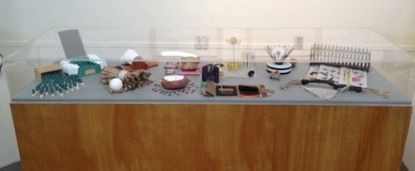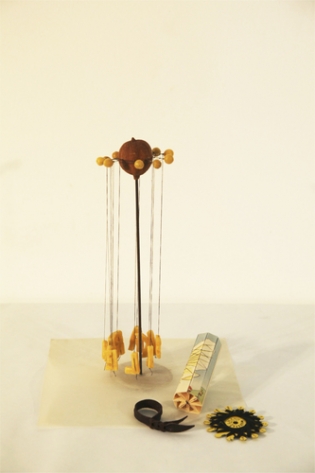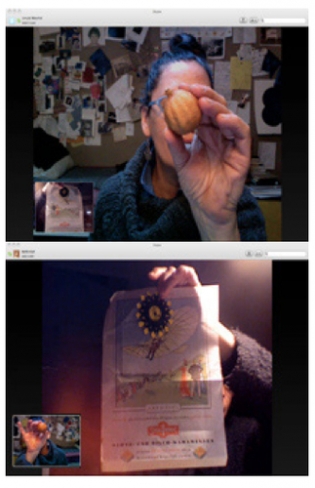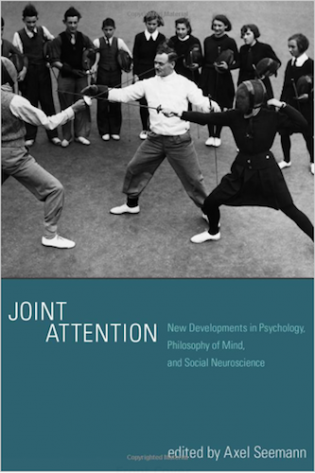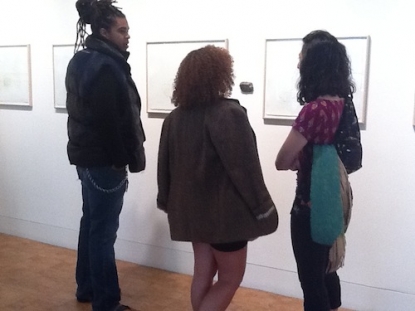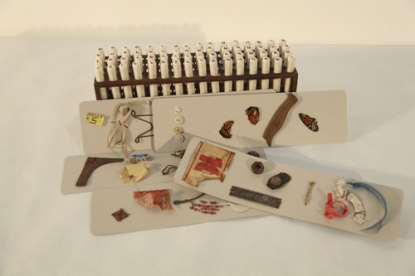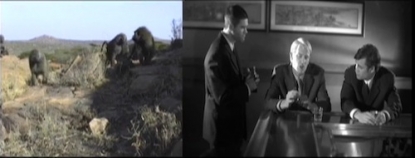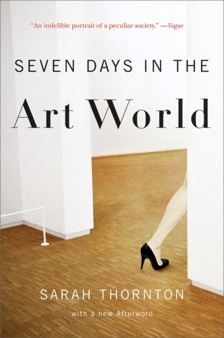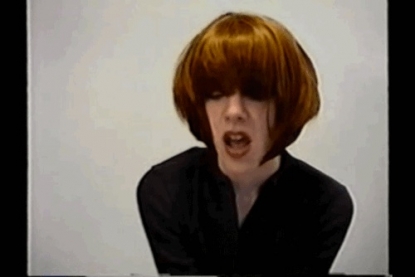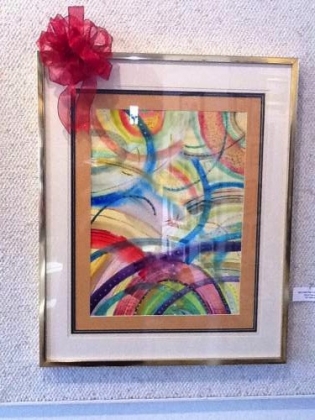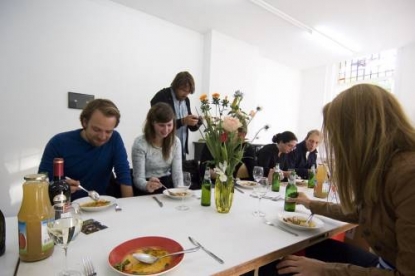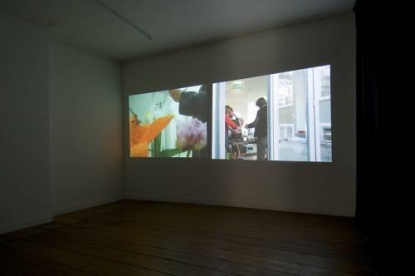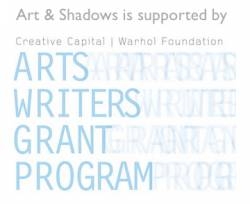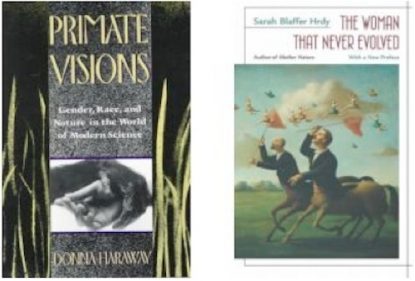
Covers of two must-read books for thinking about humans as primates: Primate Visions by Donna Haraway and I by Sarah Blaffer Hrdy.
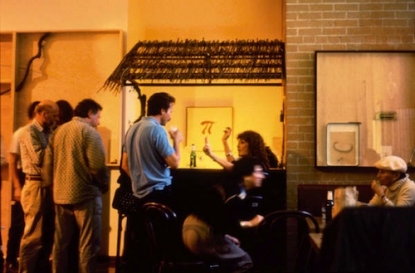
Tom Marioni, Drinking Beer with Friends is the Highest Form of Art (1970- ) as shown at the Hammer Museum at UCLA in 2010. Photo courtesy the Hammer Museum at UCLA.
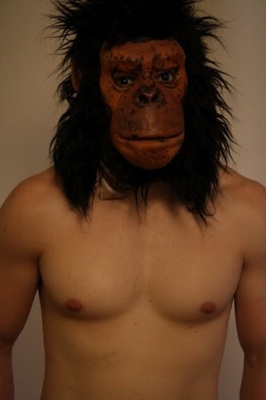
Rachel Mayeri, Primate Cinema: Apes as Family (developme
nt still, 2011). Photo by Matt Chaney. The Director of Photograph y, PJ Raval.
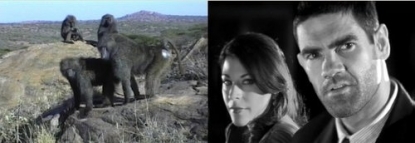
Still from Baboons as Friends (2007)
Primatologist Deborah Forster took the footage on the left screen in the course of her research. As Forster narrates the action, several males vie for access to a female. On the right screen, actors recreate the drama in human terms.

Still from How to Act Like an Animal (2009)
The workshop participants on the left screen have discussed what it means to "act like a chimpanzee" with Forster. Here, they watch the excerpt from The New Chimpanzees, the nature documentary they will re-enact, that appears on the right screen.

Still from Apes as Family (2011)
On the left screen, a chimpanzee watches the scene shown on the right screen, in which the heroine forages near a freeway.

Still from Apes as Family (2011)
At the other viewing location, an indoor enclosure that the chimpanzees could freely visit, a troop member watches as our heroine returns to her nest.

Still from Apes as Family (2011)
On the right screen, the animated story becomes slyly circular and self-referential, as a scientist and lab monkey watch a documentary of apes in the wild.

Still from Apes as Family (2011)
The chimpanzee heroine is played by an actress in an animatronic suit, with eyes controlled by a puppeteer. Her realistic appearance differentiates her from the troop that will soon invade her home, who are more clearly human actors.

Still from Apes as Family (2011)
The mayhem in the kitchen provokes a strong reaction from a chimpanzee viewer.
Feature: Projects
Art & Shadows
- February 12, 2012
What We Talk About When We Talk About Art
If you hang out in an art school, you hear a lot of talk about "art as discourse." It's a thought that is almost worn out, yet ideas become commonplace because they are apt. And sometimes an artist can extract a combustible bit of material from the ashes of cliché. In their playful, collaborative work Object Lessons (2012) Robin Hill and Ulla Warchol (working together as Biolunar L) tease the notion of "art as discourse" to life.
Object Lessons is a collection of 24 things, arranged together in a vitrine. It's hard to tell what they are. Each thing is composed of other, recognizable things—a dried lemon, a memo skewer, thread. Individually the parts make sense. But their syntax, their order in relationship to each other, skews what they have to say. That lemon, which on my counter would say "compost," says something else when it is perched on a spike, wearing a midriff halo of balls dangling threads. It says a lot of things simultaneously: orbital model, carnival, scraper wheels. It says "whirl" and "balance;" "swing" and "lift," grabbing associations from different corners of experience and and flickering between scales from macro to micro.
But it's not only in "reading" the parts together that this collection constitutes a "discourse." Hill and Warchol, long-time friends who are now separated from each other by the breadth of eight states, literally used the objects to "talk" with each other. They both had, as artists will, collections of "interesting stuff" in their studios, objects that were stuck in limbo—too inspirational to toss, but not inspirational enough to have become actual work. Anyone who has made art themselves would recognize the genre. It includes remainders, like a white plaster disk from the bottom of a bucket used to cast something else; souvenirs, like an English needlebook; and worthless treasures, like a junk-drawer box with buttons, feathers, and dried-out rubber bands that Warchol's children scoured from under a table at the Lambertville, New Jersey flea market.
To get Object Lessons going, Hill and Warchol defined a system. First, they each gathered twelve cool but orphaned objects from their studios. Then they made a cross-country Skype exchange, in which they simultaneously held up an objects for each other to view. The ground rules for this conversation-through-things were 1) No discussion beyond description of physical properties (weight, size, texture, smell, taste, color….) 2) Try to really SEE the object being shown 3) Make a work from the object shown incorporating something noticed about the object seen. Eventually, the artists joined up in Hill's studio and unveiled the object-responses to each other.
The viewing ritual was documented in a small book with screen grabs from the Skype exchange, but you don't need the book to perceive the relationships. If one sliced open the mummified lemon, for example, you would have the structural model for the tube created from the Karamelle advertisement, which has a balsawood armature based on the inner membranes of the fruit. It's a sort of stretch-limo of a lemon shape, and it's funny.
I loved the sly humor and friendly feeling that floats through the piece, but Object Lessons really caught my attention because I've been mulling over a concept from psychology called "joint attention." As defined in Joint Attention: New Developments in Psychology, Philosophy of Mind, and Social Neuroscience, edited by Axel Seemann and hot off the MIT Press, joint attention is "the capacity to attend to an object together with another creature."
A lot of subtle thinking is folded into this short definition. For example, simply looking at something at the same time is not joint attention. As psychologist Michael Tomasello writes, "A sightseer and a mountain climber attend to very different parts of a mountain (e.g. to its coloration or its slopes) in light of their very different goals."
Psychologist Inge-Marie Eigsti, who studies the interaction of language and brain development, tells her students that joint attention "is critical for social development, language acquisition, and cognitive development…", and it has become an important topic for research in part because difficulties with joint attention may be connected with autism. Eigsti, like most psychologists working in this area, studies children. But as an artist/writer who spends a fair amount of time looking at people looking at art, I've been wondering if there is something about art that stimulates, exercises, or develops joint attention in a particularly adult way.
Many of our uses for art are not social, of course. Watch exhibition-goers and you will notice different kinds of attention. Some people are speeders, glancing at each object for a second. Some people are skippers, looking at just a few works, guided by taste or an audio tour. And some people are soakers, contemplating everything. Then there are the socializers, who come in two types: those who are chatting about something else as they stroll through the show, and those who are interacting simultaneously with the works and with each other. It's this latter group I'm curious about; perhaps they are having an echo of the experience that was purified, intensified, and turned into art by Object Lessons.
Does an exchange mediated through objects help people think together? Do the challenging complexities of art OBJECTS, in particular, increase the odds of joint viewers skidding together into insights they would never, otherwise, have experienced? It's my bias to think so, which doesn't mean that I'm not equally interested in art ACTIONS, just that I think that objects offer distinct opportunities that may be related to subjects like joint attention and social cognition. In my next post I will tackle a possible problem with this idea, raised by Dr. Anjan Chatterjee, but in the meantime let's hear what Hill and Warchol have to say about the outcome of Object Lessons.
In the introductory essay to the book, they write, "Upon Warchol's arrival in California the artists structured an unpacking session in Hill's Woodland studio, in which the transformed objects faced each other for the first time. What emerged was a tender and surprising experience of reciprocity."
"We felt seen," they told me. This is a rare and precious feeling. As neuroscientist Antonio Damasio writes, “The fact that no one sees the minds of others, conscious or not, is especially mysterious.” Object Lessons walks us right up to this mystery of what we cannot know about each others' thoughts, and the pleasures of signaling to each other, anyway.
Object Lessons by BiolunarL is on view in the exhibition "Left to Chance: In Search of the Accidental Book Art," curated by Hanna Regev, at the Austin Burch Gallery of the San Francisco Center for the Book, 300 DeHaro Street, San Francisco, CA, USA, through May 12, 2012.
All images not otherwise identified are of the work Object Lessons, 2012, by BiolunarL. Courtesy of the artists.
Links:
Robin Hill's website http://robinhill.ucdavis.edu/
San Francisco Center for the Book http://sfcb.org/
February 12, 2012
Reading Other Minds, Part II
It has been shown, by thinkers such as Donna Haraway and Sarah Blaffer Hrdy, that opining about human nature on the basis of primatology research is an excellent way to reveal your deepest, darkest, most unflattering beliefs about human existence. Closet sexist? Oops—your macho is showing. (See Hrdy's The Woman Who Never Evolved.) Secretly a bit racist? Not a secret anymore. (Check out Haraway's Primate Visions). Tantalized by "alternative" sexualities? You might as well march down Main Street in leather gear as theorize about bonobos. (C.f. Ian Parker's "Swingers".)
So before I promised that today we would take a look at an art opening as a primate gathering, I probably should have gulped and looked for another topic. But ever since I saw the first video in Rachel Mayeri's Primate Cinema series, Baboons as Friends, I spot nervous students hanging around the fringes of an opening and flash on juvenile apes, figuring out their place in the social structure. If I notice an artist chatting up a prominent curator, I imagine Mayeri's collaborator, primatologist Deborah Forster, narrating the scene: "The artist and the curator are in consort…the artist at this point already knows that he's probably going to lose the curator's attention because it's near the end of the opening, and as the other power players invited to the dinner hosted by the gallery arrive, the curator will want to talk to them. The curator is very confident, he's probably getting antsy because the artist's insecurity is getting in the way of his ability to conduct an entertaining conversation…."
That's a riff on Forster's recounting of the primate action in Baboons as Friends, with just a little more than the names changed to make it apply to an opening. There may be truth in this slant on the art world's favorite social custom, but what good does it do to think of it this way? There are reasonable people out there who get very irritated with suggestions that the study of animals yields useful information about humans. These enforcers patrol the human-animal boundary because blurring it—by classifying some people as "animals"—has often justified human exploitation.
So instead of thinking "animalistically," we could just go with a primatologist who specializes in humans—i.e. an anthropologist—such as Sarah Thornton, whose 2009 best-seller Seven Days in the Art World (translated into 14 languages) contains many luscious examples of social maneuvering in the art context. For example, on page 222, Thornton records this important art speak at the Venice Biennale, delivered by an unnamed acquaintance: "'He's C list. She's B list,' he said, as he fingered people out of the crowd. 'Nick Serota is A list,' he added for clarification."
(Sir Nicholas Serota, in case you're wondering, is the Director of the Tate in Britain.) But crack observer that Thornton is—she took a lot of notes on things her companions probably didn't think she saw—she doesn't go deeply into opening culture. Perhaps we could turn to an artist for insight. Peter Davies's painting The Hip One Hundred (1998) is an oldie-but-goodie satirizing the social sorting that Thornton reports, but Davies doesn't really address openings, either.
Conceptual artist Tom Marioni's long-running The Act of Drinking Beer with Friends is the Highest Form of Art (1970- ) (yes, the title is descriptive) could be regarded as a sort of meta-opening, but it is in no sense analytical. Someday Jayson Musson or Alex Bag, both video/performance artists who satirize the art world, may produce the definitive work on openings, but unless I missed something, that hasn't happened yet. (That I missed something is entirely possible, but I did conduct a great deal of enjoyable research trying to find out…if you'd like to draw your own conclusions, their works are linked below. Let me know if you find a bit I missed.)
Are the ins and outs of art openings more comfortably the province of fiction or film? You may recall that Jeff in Venice, a 2009 novel by Geoff Dyer, takes a entertainingly sardonic look at the parties around the Venice Biennale, and (Untitled), a 2009 film by Jonathan Parker, spoofs a very believable gallery opening in New York. But hey, there's a reason this stuff came out in 2009, in the wake of a big-time boom in the art market and therefore a time when deflating art world pretensions seemed like a particularly worthy project. But the processes I'd like to talk about aren't predicated on success; I suspect that they operate at openings in student galleries around the world just as vigorously as they do at the Biennales. And a cynical approach, however entertaining, isn't going to take us anywhere we haven't already been.
So we're back to primatology. Openings, like other human social forms, have many variations. But they have in common that something novel is on display, and that a group congregates to socialize in connection with the display. Although most openings are public affairs, the attendees tend to have more in common than, for example, a crowd moving through a shopping mall. They are also more different from each other, more varied, than a group of people participating in a private social event—an extended family, or workers at the same company. So the structure of an opening contains an exciting commingling of social possibilities…there are existing relationships to nurture, alliances to strengthen, and also new people to meet, new connections to be forged. There is a common topic of conversation at hand, and of course the wine, to ease social exchange. But no one can pay attention to everyone, so social choices have to be made.
All of of which means that an opening gives our hardwired primate sensitivity to social status a workout. This is not the same as saying that the art doesn't matter—it does, for all the reasons we might normally think it does and also because it facilitates what psychologists might call "joint attention"—more on that in a future post. But in the context of an opening, it is a rare viewer who isn't, on some level, aware of the people around her, calculating who to stand next to and who to avoid, and noticing who is and isn't getting attention from other people. The baboons would understand.
Links:
Alex Bag's Untitled '95 (1995), First Semester and Seventh Semester
Jayson Musson (Hennessy Youngman) Artthoughtz Youtube channel
Tom Marioni's website
February 5, 2012
Reading Other Minds, Part I
I've found Rachel Mayeri's Primate Cinema captivating ever since I saw the first video in the series, Baboons as Friends (2007). The questions she tackles—questions about our human nature, our place in the world, and how we explain the world to ourselves—seem so fundamental, and are treated with such humor, that any rough spots in the work just emphasized the ambition of her project, and made me root for its further development. So the arrival of her Apes as Family, a new two channel video installation, at Arts Catalyst in London, was an occasion.
Apes as Family continues the series of cross-species dramas drawing on popular media and scientific studies. Baboons as Friends juxtaposed research footage of male baboons competing for the attentions of a female with a human reenactment mirroring the baboons' actions—suggestively set in a bar and styled as film noir. Mayeri followed it up with How to Act Like an Animal, in which humans imitate a National Geographic documentary on the chimpanzee troop that Jane Goodall studied. In the clip Mayeri chose for re-enactment, the chimpanzees hunt and eat a colobus monkey, literally ripping it limb from limb. Sex, violence, survival…as the wild footage plays against the often hilarious recreations, viewers are squarely caught between humor and horror.
In her new work, Mayeri kicked it up a notch by actively participating in the research. She spent a year working with comparative psychologist Sarah-Jane Vick, showing different kinds of video to the chimpanzees who reside at the Edinburgh Zoo. Did they prefer cartoons? Dramas? Nature shows? Television at the zoo is not as odd as you might think. Apes get bored in captivity, so best practices for their care include providing entertainment. Many zoos offer their apes television, whatever is on, and some apes like to watch. The "Budongo Trail" housing the Edinburgh apes is the world's largest habitat for captive chimpanzees, and historically the Zoo has eschewed television, priding itself on offering more "natural" enrichments. But when the time came to introduce new chimpanzees to the group—a process which can rival the worst fraternity hazings—"video introductions" were used to build familiarity between the parties before they actually met.
So Mayeri's proposal, to make a drama FOR the chimps, in terms that would be meaningful to them, was not particularly farfetched. It was just the first time a human filmmaker placed her imaginative resources at the service of another species. The ins and outs of that effort, what is and is not possible to transmit across species boundaries, deserve philosophic and semiotic discussion. But before we go there, let's talk about what Mayeri actually did. In the film, human actors portray a normal event in the life of a female chimpanzee: a band of strangers arrives in her territory, and she has to negotiate with them to survive. The storyline is chimp-plausible; the setting is humanoid. As the film begins, we see a lone chimpanzee foraging in the trees near a freeway; after this day at work she returns home to an apartment well-stocked with fruits and vegetables and selects a snack to eat in the bedroom while she watches TV. But as she rests, a foreign band of chimps invades her home, eating her food and having sex in her kitchen.
When this film debuted to its chimpanzee audience, it was screened in two settings where the chimps were free to come or go. They're a tough crowd, always more alert to the activities and sexual availability of their companions than to the screen, but they do respond to the video, sometimes quite intensely. In the installation, the drama is synced with film of its debut at the zoo, so we are simultaneously watching the drama and the chimpanzees watching the drama. At one point the layers ramify, as we watch a chimpanzee at the zoo watch a human actor in a chimpanzee suit watch an animation of a chimpanzee in a lab watching a chimpanzee in a nature documentary. And, oh, by the way, there's a copy of Donna Haraway's majestic theoretical work, Primate Visions, on the bedside table of the human-actor-chimp. Just in case we need a hint as to how to think about all this watching. (Haraway famously analyzed the projections of human social structure into scientific descriptions of primate relationships, a chain of reference that Mayeri's work practically twists into a Möbius strip.)
But what do we get from this that we couldn't get just watching chimps in the zoo? Why should we as humans want to watch video made with another species in mind? It's not like we don't have enough video made just for us to consume. But, as Mayeri says, "The two channels create a prism for human beings to learn about the inner world of chimpanzees." And, as she doesn't say, learning to put the non-human at the center of our thoughts, experiencing what it might be like to exist in conversation with other species rather than in control of them, could mean the difference between creating a sustainable future or a world of misery for ourselves. Which grand thought comes down to earth in next week's post, in which we take off from Apes as Family to imagine an art opening as a primate social drama.
Links:
Rachel Mayeri's website
Trailer for Baboons as Friends
Trailer for Apes as Family
January 29, 2012
Interrogating a Red Ribbon
Today I dropped into the Carnegie Art Center in Goodland, Kansas, a county seat on the state's Western flank. Goodland has a population of 4,948 people and one of them is my father, so although I've never lived here myself, I've visited with some regularity. The art center is in a landmark stone building put up in 1913 as the Carnegie Library; after the town built a bigger library, the art council took it over. In January, the calendar of exhibitions has a pause for rest and grant-writing. So the walls were still hung with a group show put together for the holidays, including Beyond the Universe, an abstract watercolor attributed to Elwyn Vatcher, gallery volunteer, and adorned with a big, red bow.
That red bow was a complication, a signifier, a sign to me that I am, really, still in Kansas, although Vatcher's painting speaks a modernist language that is now familiar almost everywhere. The ribbon is blatant, sweet, pushy (its red loops insist on echoing the red arcs in the painting); a little shocking to someone accustomed to more discreet displays. I don't know what it meant to the gallery; to me it straddled the line between a red dot and a county fair prize with a dollop of "I'm a gift" thrown in. Back in California I might have taken it as a bit of ironic assemblage; but a few other pieces also sported bows so I'm pretty sure that whatever it meant, it was sincere.
And I'm inclined to appreciate that sincerity, having received some of my own art education at a similar community gallery in Wichita. As I look out towards the prairie from my hotel room, it seems right that this first Art & Shadows should come from Kansas, and from a small town. The questions I want to explore in this blog, questions about the art world and about what art is, how we know art when we see it, and what it means in our lives, are my questions in part because of where I grew up. I am passionately involved with contemporary art, but I've never gotten comfortable with the disconnect between art now and art here. For example, there's a lot of talk about "community" in the works I encounter in my everyday life as an artist, writer, and teacher; but the thinking doesn't always seem to encompass the kind of community consciousness shared by the rural people who live here. Sometimes the word seems to mean as many different things as that red bow.
Back in my hotel room, the view doesn't deliver a lot of inspiration, so I go online and discover the work of Thai artist Arin Rungjang, through art historian Moira Roth's highly-recommended blog Gleanings (part of the upcoming Biennale of Sydney). Roth links to video from Let's Make Sense, a 2011 project in which Rungjang taught a group of Dutch people to cook Thai food. He talks about the dinner that resulted, at West, a gallery in Den Haag, as a spiritual experience, sharing food, talking about daily life and common experiences. In some ways it's the kind of experience that probably happens in Goodland on most Sundays. But framed by a gallery it seems more significant somehow—perhaps not least in that the participants must have a degree of self-consciousness about what they are doing; it's special, not "normal."
"Making special" is what makes art Art and there are good biological reasons why that would be the case, according to evolutionary theorist Ellen Dissayanake (whose ideas we will discuss further in future posts.) Whatever "community" builds at the dinner will most likely be fragile and transient—it's hard to imagine calling on someone you met once at a gallery to pick your kid up at school or bring you soup when you have the flu. But if working with Rungjang makes his audience think about community, noticing its presence in their life in a different way, then by Dissayanake's lights the project would be a successful work of art.
But it could go further. The word "community" is often used in art discourse as if it referred to a positive good, something equivalent to health or happiness. But it simply means "a social group of any size," and the formation of social groups is, by definition, an exclusionary as well as an inclusionary process. Some people are in and some people are out. Rungjang's own family was scarred by an exclusionary manifestation of community: while in Germany as part of a ship's crew, his father was beaten so badly by a group of Neo-Nazis, apparently just for being Asian, that he lost consciousness for two days. He died a year later, having never fully recovered his health. When Rungjang talks about his art, he attributes his motivation to this family tragedy, telling Roth that "it brought me to my interest in the ideologies of the world and the separations that they establish between people."
Rungjang is to be lauded for tackling a big question—in his next project, a video for the Biennale of Sydney, he works with children who were orphaned by the malignant community feeling that erupted in the Rwandan Genocide. I am curious to see how his rhetoric about community develops through this work. In the meantime, next week Art & Shadows will pursue an investigation into social groups and the roots of art through the videos and installations of Rachel Mayeri, creator of Primate Cinema. And maybe, eventually, get back to the subject of "making special" and that big red bow.
Links:

